
|
|
Font Size:
|
||||
|
|
|
|
||||
STATISTICAL BRIEF #137:
Treatment of Sore Throats: Antibiotic Prescriptions and Throat Cultures for Children under 18 Years of Age, 2002-2004 (Average Annual)
Highlights
- On average during 2002-2004, contact was made with a health professional regarding a primary sore throat condition within a 12-month period for 14.0 percent of children under 18 years of age. Of these children, over two-thirds (69.7 percent) were prescribed antibiotics to treat their sore throat.
- Approximately one of every five children who were prescribed an antibiotic did not receive a throat swab before receiving the prescription.
- Among children who had contact with a health professional for a sore throat, those age 13-17 were less likely to have an antibiotic prescribed than younger children.
- Children in metropolitan statistical areas with sore throats were less likely to be prescribed an antibiotic than children in other areas but were more likely to have a throat swab before a prescription.
Introduction
Upper respiratory infections are common in children, and inappropriate treatment of these infections with an antibiotic is a public health concern. In particular, inappropriate use can have a negative impact on the effectiveness of antibiotics and increase the risk of infection with a drug-resistant pathogen.*
The Michigan Quality Improvement Consortium recommends the following treatment of acute pharyngitis in children:†
- High risk children (those with past history or household exposure of rheumatic fever) and those whose symptoms indicate a high probability of streptococcus pharyngitis should start antibiotics immediately, but if a throat culture is obtained and the result is negative the antibiotics should be stopped.
- Antibiotics should not be prescribed for children whose symptoms indicate a low probability of streptococcus infection.
- A throat culture (or rapid screen test) should be obtained for children with an intermediate probability of streptococcus and, if the result is positive, antibiotics should be prescribed.
Findings
On average during 2002-2004, contact was made with a health professional regarding a primary sore throat condition within a 12-month period for 14.0 percent of children under 18 years of age (figure 1). Of these children, over two-thirds (69.7 percent) were prescribed antibiotics to treat their sore throat. Approximately one of every five children (22.0 percent) who were prescribed an antibiotic did not receive a throat swab before receiving the prescription.
Age
The likelihood of contact with a health professional for a serious sore throat varied by age, ranging from 10.2 percent for children under age 5 to 16.5 percent for children 5-12 years of age (figure 2). Teenage children 13-17 years of age were less likely to have an antibiotic prescribed for a sore throat than younger children (65.3 percent versus 71.1-72.4 percent for the younger age groups). Children 5-12 years of age who were prescribed an antibiotic were more likely to have a throat swab before the prescription (81.7 percent) than younger (70.1 percent) or older (76.5 percent) children.
Race/ethnicity
White non-Hispanic children were most likely (16.6 percent), and black non-Hispanic children were least likely (7.9 percent) to have contact with a health professional regarding a serious sore throat (figure 3). While there was no significant variation by race/ethnicity in the likelihood of being prescribed an antibiotic, white non-Hispanic children were significantly more likely to have had a throat swab before prescription than Hispanic children (80.5 versus 72.1 percent). Differences between white children and the other two race/ethnicity groups were not statistically significant.
Insurance status
Children with private insurance were more likely to have contact with a health professional for a serious sore throat (15.3 percent) than those with public only insurance (12.2 percent) or uninsured children (10.4 percent) (figure 4). Uninsured children were less likely to have an antibiotic prescribed for a sore throat (64.2 percent) than children with public only insurance (72.9 percent). Children with private insurance were more likely to have a throat swab prior to an antibiotic prescription (80.8 percent) than children covered by public only insurance (70.9 percent).
Region
Children in the West were less likely than children in other regions to have contact with a health professional regarding a serious sore throat (11.1 percent versus 13.6-17.4 percent) (figure 5). Children in the South were most likely (74.7 percent) to have an antibiotic prescribed for treatment of a sore throat, and children in the Northeast were most likely to have a throat swab before prescription (85.4 percent).
Metropolitan versus nonmetropolitan area
The likelihood of contact with a health professional for a serious sore throat was not significantly different for children living in metropolitan statistical areas (MSA) and those living in other areas. Children in MSAs with sore throats were less likely to be prescribed an antibiotic (67.8 percent) than children in non-MSA areas (77.6 percent) but were more likely to have a throat swab before a prescription (81.1 percent) than children in non-MSA areas (66.5 percent) (figure 6).
Data Source
The estimates in this Statistical Brief are based on data from the MEPS 2002 Full Year Consolidated Data File (HC-070), the MEPS 2003 Full Year Consolidated Data File (HC-079), and the MEPS 2004 Full Year Population Characteristics Data File (HC-082).
Definitions
Sore throat survey questions
Beginning in 2000, a series of questions were asked in the MEPS Quality Priority Conditions Supplement about the prevalence and treatment of sore throats for children under 18 years of age. The estimates in this brief are based on responses to the following questions from this supplement:
Let's talk about the last time (PERSON) had a sore throat that was serious enough to cause you to contact a doctor or other health professional.
- Did this happen during the past 12 months?
- Was that primarily because (PERSON) had a sore throat or was it primarily for other symptoms?
- Did a doctor or other health professional prescribe an antibiotic for (PERSON)?
- Did a doctor or other health professional give (PERSON) a throat swab before giving (PERSON) the antibiotic prescription?
Racial and ethnic classifications
Classification by race and ethnicity is based on information reported for each family member. Respondents were asked if each family member was Hispanic or Latino. Respondents were also asked which race or races best describes each family member. Race categories include white, black/African American, American Indian or Alaska Native, Asian, Native Hawaiian or other Pacific Islander, and other. Based on these questions, sample persons were classified into the following four race/ethnicity categories: Hispanic or Latino, white non-Hispanic or Latino single race, black non-Hispanic or Latino single race, and other single race or multiple races non-Hispanic or Latino.
Health insurance status
Children were classified in the following three insurance categories, based on household responses to health insurance status questions:
- Any private health insurance: Individuals who, at any time during the year, had insurance that provided coverage for hospital and physician care (other than Medicare, Medicaid, or other public hospital/physician coverage) were classified as having private insurance. Coverage by TRICARE (Armed Forces-related coverage) was also included as private health insurance. Insurance that provides coverage for a single service only, such as dental or vision coverage, was not included.
- Public only coverage: Individuals were considered to have public only coverage if they met both of the following criteria: 1) they were not covered by private insurance at any time during the year, 2) they were covered by one of the following public programs at any point during the year: Medicare, Medicaid, or other public hospital/physician coverage.
- Uninsured: The uninsured were defined as people not covered by private hospital/physician insurance, Medicare, TRICARE, Medicaid, or other public hospital/physician programs at any time during the entire year or period of eligibility for the survey.
- Northeast: Maine, New Hampshire, Vermont, Massachusetts, Rhode Island, Connecticut, New York, New Jersey, and Pennsylvania
- Midwest: Ohio, Indiana, Illinois, Michigan, Wisconsin, Minnesota, Iowa, Missouri, North Dakota, South Dakota, Nebraska, and Kansas
- South: Delaware, Maryland, District of Columbia, Virginia, West Virginia, North Carolina, South Carolina, Georgia, Florida, Kentucky, Tennessee, Alabama, Mississippi, Arkansas, Louisiana, Oklahoma, and Texas
- West: Montana, Idaho, Wyoming, Colorado, New Mexico, Arizona, Utah, Nevada, Washington, Oregon, California, Alaska, and Hawaii
Areas designated by the U.S. Office of Management and Budget that are composed of a large population nucleus combined with adjacent communities that have a high degree of economic and social integration with the nucleus. An MSA has one or more central counties containing the area's main population concentration.
About MEPS-HC
MEPS-HC is a nationally representative longitudinal survey that collects detailed information on health care utilization and expenditures, health insurance, and health status, as well as a wide variety of social, demographic, and economic characteristics for the civilian noninstitutionalized population. It is cosponsored by the Agency for Healthcare Research and Quality and the National Center for Health Statistics.
For more information about MEPS, call the MEPS information coordinator at AHRQ (301-427-1656) or visit the MEPS Web site at http://www.meps.ahrq.gov/.
References
For a detailed description of the MEPS survey design, sample design, and methods used to minimize sources of nonsampling error, see the following publications:Cohen, J. Design and Methods of the Medical Expenditure Panel Survey Household Component. MEPS Methodology Report No. 1. AHCPR Pub. No. 97-0026. Rockville, Md.: Agency for Health Care Policy and Research, 1997.
Cohen, S. Sample Design of the 1996 Medical Expenditure Panel Survey Household Component. MEPS Methodology Report No. 2. AHCPR Pub. No. 97-0027. Rockville, Md.: Agency for Health Care Policy and Research, 1997.
Cohen, S. Design Strategies and Innovations in the Medical Expenditure Panel Survey. Medical Care, July 2003: 41(7) Supplement: III-5-III-12.
Suggested Citation
Machlin, S. R. and Carper, K. Treatment of Sore Throats: Antibiotic Prescriptions and Throat Cultures for Children under 18 Years of Age, 2002-2004 (Average Annual). Statistical Brief #137. August 2006. Agency for Healthcare Research and Quality, Rockville, Md. http://www.meps.ahrq.gov/mepsweb/data_files/publications/st137/stat137.shtml
AHRQ welcomes questions and comments from readers of this publication who are interested in obtaining more information about access, cost, use, financing, and quality of health care in the United States. We also invite you to tell us how you are using this Statistical Brief and other MEPS data and tools and to share suggestions on how MEPS products might be enhanced to further meet your needs. Please e-mail us at mepspd@ahrq.gov or send a letter to the address below:
Steven B. Cohen, PhD, Director
Center for Financing, Access, and Cost Trends
Agency for Healthcare Research and Quality
540 Gaither Road
Rockville, MD 20850
Footnotes
* National Committee for Quality Assurance (NCQA): The State of Health Care Quality 2004; HEDIS Measures; Appropriate Testing for Children with Pharyngitis. http://www.ncqa.org/tabid/346/Default.aspx
† Michigan Quality Improvement Consortium. Acute pharyngitis in children. Southfield (MI): Michigan Quality Improvement Consortium; 2004 Apr. 1 page. NGC: 004557. http://www.guideline.gov/summary/summary.aspx?doc_id=13823
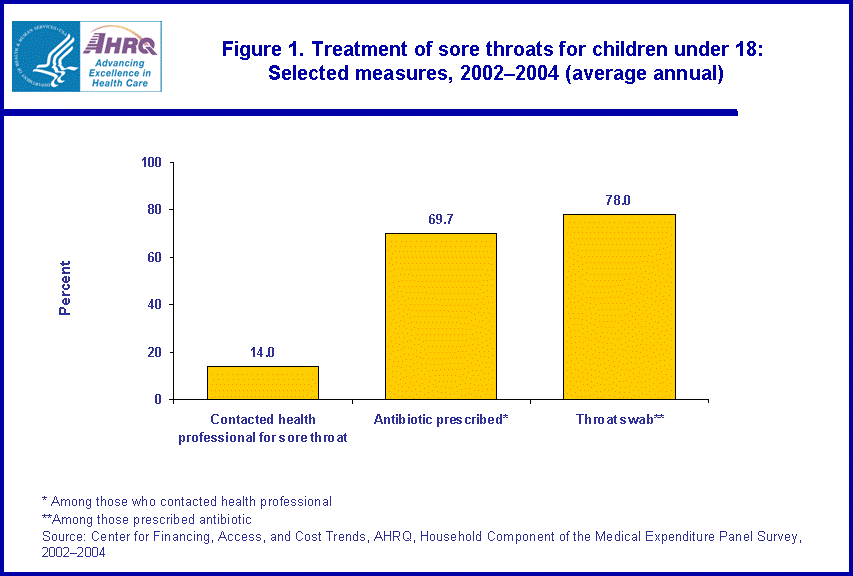 |
||||||||||||||||||||||||||||
|
||||||||||||||||||||||||||||
|
|
||||||||||||||||||||||||||||
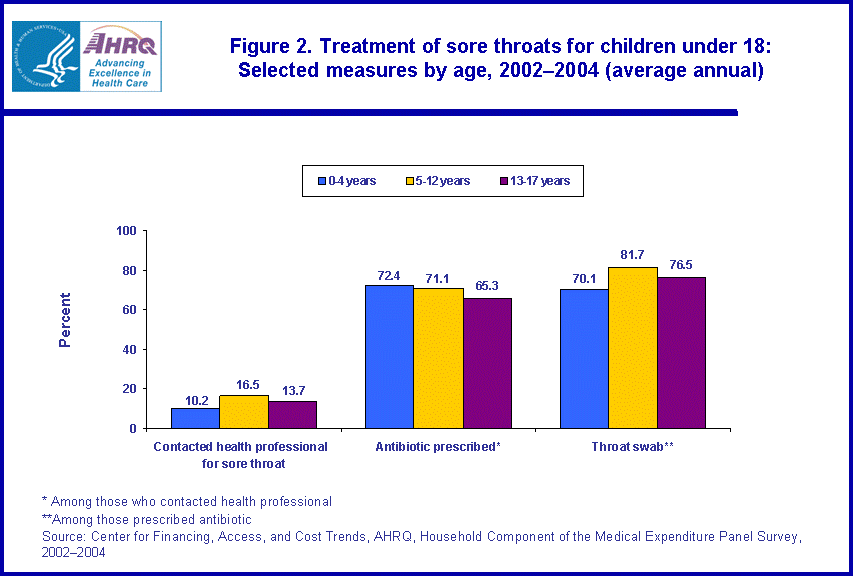 |
||||||||||||||||||||||||||||
|
||||||||||||||||||||||||||||
|
|
||||||||||||||||||||||||||||
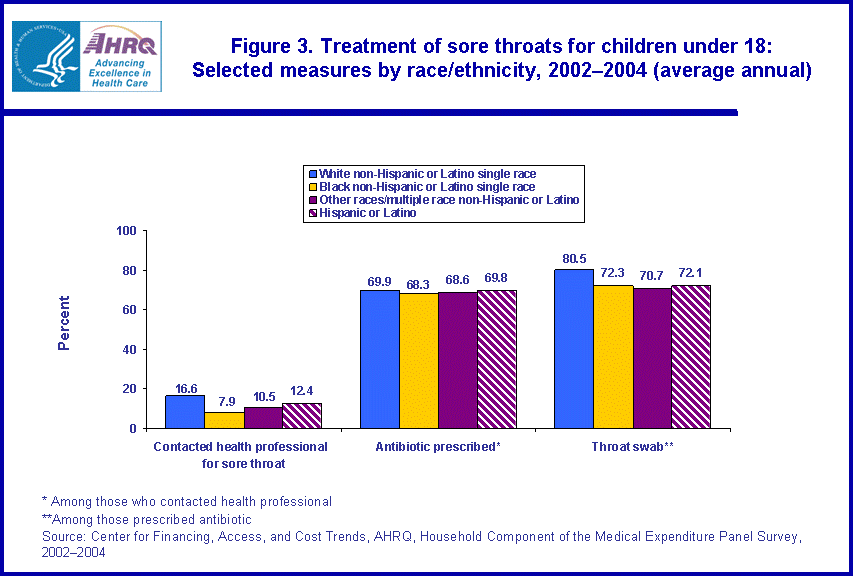 |
||||||||||||||||||||||||||||
|
||||||||||||||||||||||||||||
|
|
||||||||||||||||||||||||||||
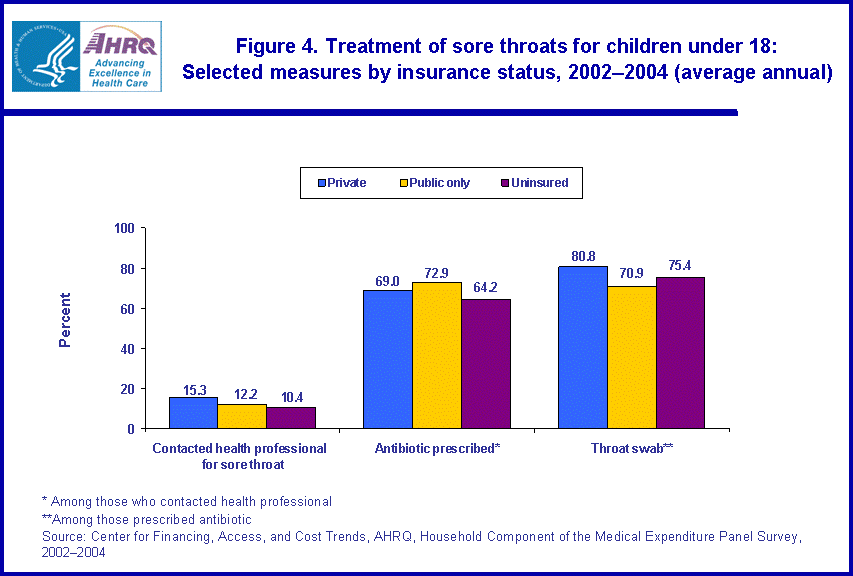 |
||||||||||||||||||||||||||||
|
||||||||||||||||||||||||||||
|
|
||||||||||||||||||||||||||||
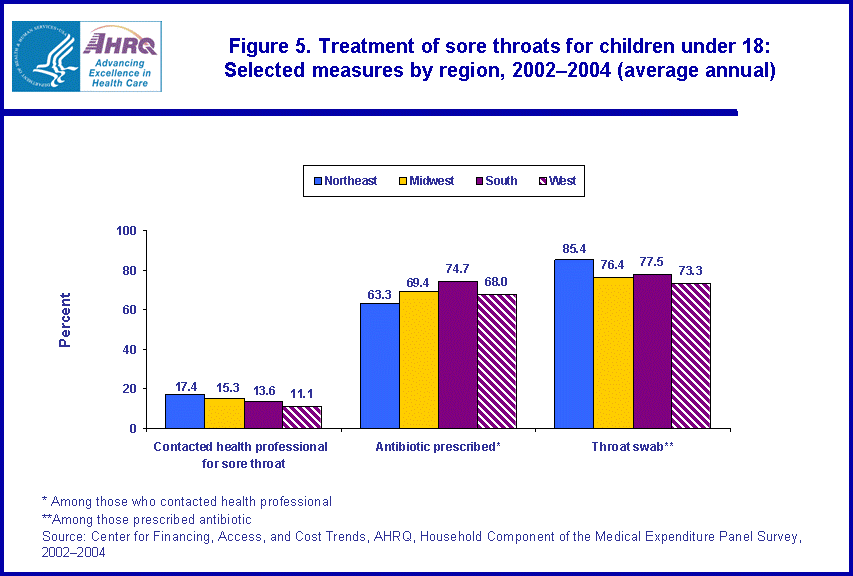 |
||||||||||||||||||||||||||||
|
||||||||||||||||||||||||||||
|
|
||||||||||||||||||||||||||||
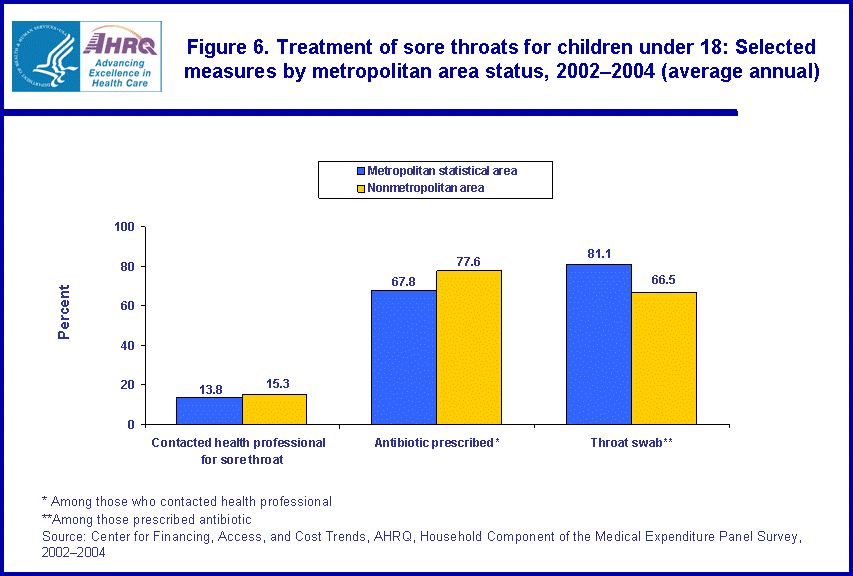 |
||||||||||||||||||||||||||||
|
||||||||||||||||||||||||||||
|
|
||||||||||||||||||||||||||||


